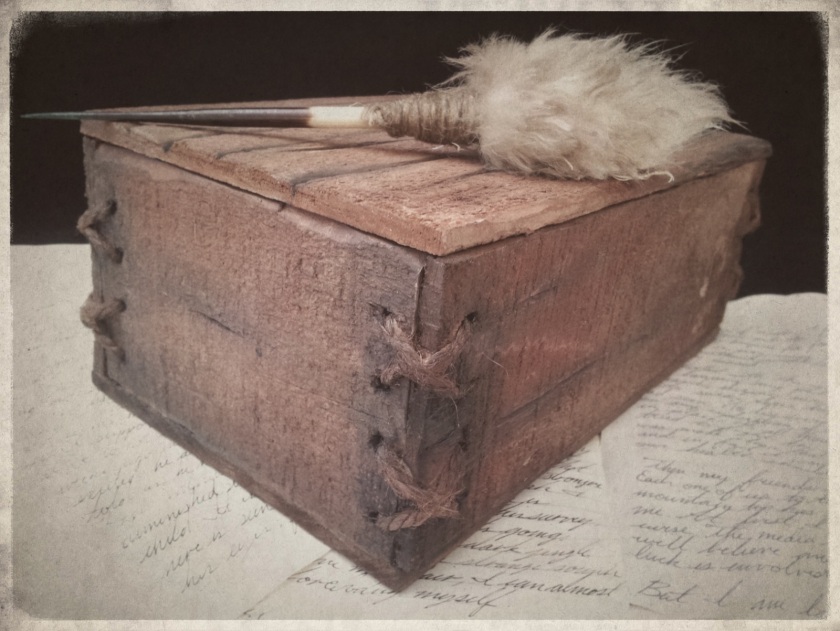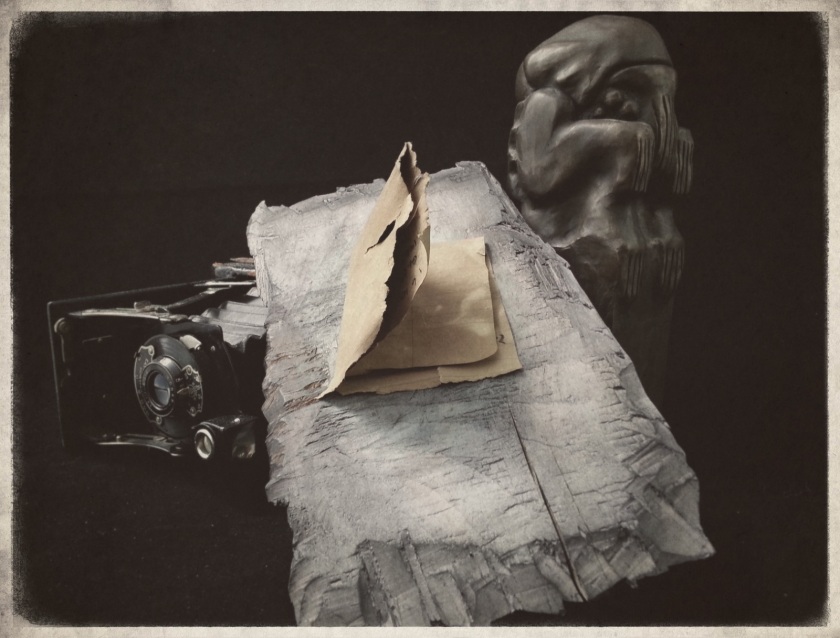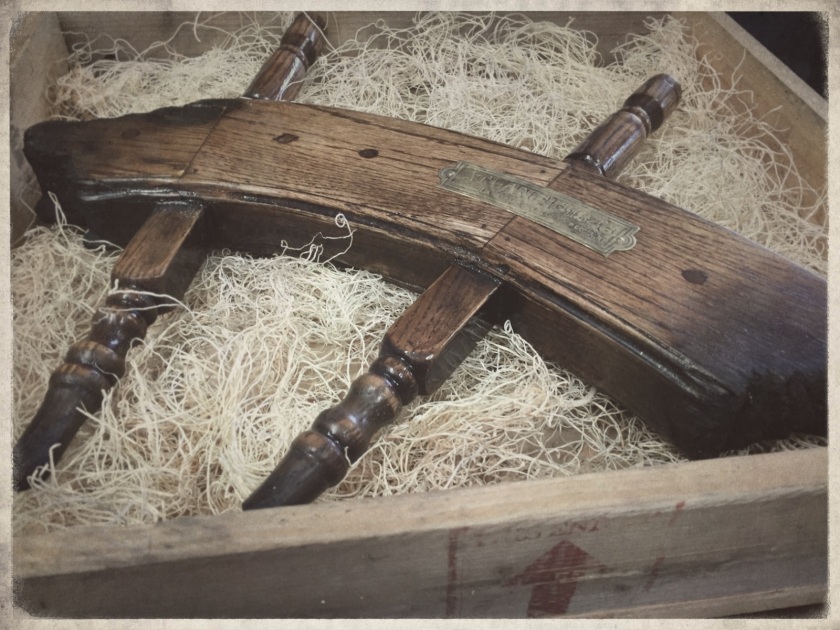The Mysterious Package Company sends story experiences through the mail. Sign up, and you or your chosen recipient gets a sequence of unexplained mailings. Inside: objects that tell a story, from documents and newspaper clippings through medium-sized statuary and significant physical props. There’s a little of a sense of the magic trick about all this, too — they even describe the stages of their presentation in terms of “The Pledge”, “The Turn”, and “The Prestige”.
Having occasionally made much less ambitious, much less polished physical props to go with my games, I’m both jealous and a bit in awe of the talent going into their work. (I’ve seen a few props that they sent to a friend, but I’ve not signed up or tried a full experience myself.)
The Mysterious Package Company are now kickstarting a larger-than-usual experience called The Century Beast, a Lovecraft-meets-Vikings story about which the pitch is alluring but vague. The Kickstarter has been funded, and is meeting further stretch goals by the day. For anyone who likes narrative of objects pieces, single-player ARG-like experiences, or feelies — especially feelies — this is likely to awaken covetous impulses.
The Company is mysterious even in its correspondence, so I don’t actually know who runs the business, but someone called the Curator was kind enough to answer my questions about storytelling in their particular format.
Tell me about the kinds of storytelling that are possible with objects that would be harder to do any other way. What are the strengths of your particular medium?
Storytelling is universal, whether it be oral, written, or performance. However, with some notable exceptions, becoming truly immersed in a story is difficult. You may relate to the characters, or be taken by the narrative, but you are observing what is happening to others, not participating yourself. The advent of video games has provided new and wonderful ways to tell stories, whilst placing the player in the role of the protaganist, and that is a large step toward creating immersion, but there is a significant missing element: physicality.
Tactile storytelling allows us to place the recipient at the centre of the narrative, an intregal part of the overall story. When they open an envelope, and pull our a piece of paper that truly feels like it is one hundred years old, it is like reliving a scene in a film. Indeed, I have referred to these as “cinematic moments”, the type of thing we find in adventures on the silver screen. The most potent aspect of these moments is that they do happen in real life. Think to the long, lazy summer days of our youth, those perfect days that are remembered with the lighting just so, or your first kiss, how the world disappeared into the background and your entire existence was cast in candlelight and long shadows.
What we do, then, is set the scene for the creation of these cinematic moments in real life, and the solidification of the memories around them. We cannot change the lighting of your kitchen table when you pry open one of our wooden crates, but when you remember it later, when you retell the story days, weeks, or years hence, those details will alter in your memory. There is a reason that we are fond of services like Instagram, where you apply filters to make your photographs factually worse: you are creating an instant nostagia for the moment you captured. You may then view and share it, not as it really was, but how you remember it to be: soft focus, perfect lighting, and faded at the edges.
Are there other stories told through objects that have been inspirations for your work?
We are a product of our culture, and our tales are steeped in the tropes of the genres we write in. The stories of Griffin and Sabine were an influence, but several of our number have played a great number of role-playing and alternate reality games. Tactile elements are critical to both tabletop and live-action role-playing, and these lessons have been applied to our stories.
What goes into planning for a new project? Are you, for instance, working out a detailed narrative first, or do you start thinking about physical representations immediately?
The specifics vary significantly depending on the story. Sometimes, we are inspired by a photograph, a prop from a film, or a description of a treasure, and we work from the final artifact backward. Other times, we begin with a sense of the story, and during our research the possible artifacts present themselves. The Artisan liaises closely with the Professor, ensuring that as new discoveries are made that they properly influence the various relics of the experience.
I noticed that it looks like some of your experiences include puzzles such as coded messages. What happens if a recipient isn’t able to solve these? Is telling the story the top priority, or is it preserving the mystery?
The story is always paramount for us, and we never wish for someone receiving our mailings to get frustrated or stuck. We also do not wish to force someone to participate, so puzzles tend to enhance the experience for those who are interested, but they are not required to enjoy it. Solving a puzzle might change the fate of a character, or provide unexpected insight into something that occured, but it never blocks a mailing from going out.
What was the most challenging item you’ve yet had to fabricate?
A piece of an exploded wooden ship’s wheel. Not only did we have to manufacture an angled piece of the wheel, but it needed to be varnished, then burned significantly at either side, then aged to over 150 years old. It included an engraved brass plate with the name of the ship and the company that built it, which was a challenge to do in and of itself.
(Okay, I admit: I’m impressed.)
Is there anything you’d like to achieve in a future Mysterious Package that you haven’t yet figured out how to accomplish?
There is a moment at the beginning of the movie The Matrix, where Neo receives a package by courier. When opened, a cellular phone is inside, which then immediately rings. We would like to find a way to recreate that moment.




Never heard of this before, but that is seriously awesome. Thanks for writing about them.
I received packages from this place. It was lots of fun since I’m a mystery author. Turns out a friend from the library was behind it. You can read about it on my post and see photos of items I received. It got wide response and several others came forward to say they, too, had received items.
https://cncbooksblog.wordpress.com/2015/09/29/when-life-imitates-art/comment-page-1/#comment-13984
This is unbelievable. Incredible. Beautifull. Thank you very much for sharing!
I couldn’t help myself. I applied for membership. :) I shall see where it takes me, if it’s even actually accepted. Thank you for bringing this to my attention! I may have missed the Infocom Feelies craze, but I can still try for this!
You can check out my experience at
https://cncbooksblog.wordpress.com/2015/09/29/when-life-imitates-art/comment-page-1/#comment-13984
Thank you for this, I’d never heard of these artifact stories.
I blogged about my experience as a receiver of such a “gift.”
https://cncbooksblog.wordpress.com/2015/09/29/when-life-imitates-art/comment-page-1/#comment-13984
Reblogged this on The Obsession Engine and commented:
I have to say that this is brilliant stuff.
I have thus far been thoroughly unimpressed with this company. I placed an order for the Century Beast on April 1. They said there would be a 30 day lead time. I figured this would be fine, as it was a birthday present, and then by early June my wife would be well into the mystery.
So I gave them 30 days plus about 2.5 weeks before gently tapping them for a status. I received an email a day later that the first package had been shipped. The second package was due to ship on May 23, with the third scheduled on June 5. Today is June 8 and I have not even received package 2, which is still marked “Pending” in my order profile. And STILL with a date of May 23. For the sheer price that I paid for this, I expect far better service. I can’t say at this point that I’ll ever be using them again. So far for my $400 I’ve gotten an envelope with a comic strip, a handwritten letter, and a couple falsified Internet documents. Unbelievably disappointing.
have you received anything else? i wanted to buy this but it doesn’t sound like anything i can’t make myself. thank you for your review as it gives me pause now.
Were you joking about the Matrix cell phone?
I might be able to give guidance